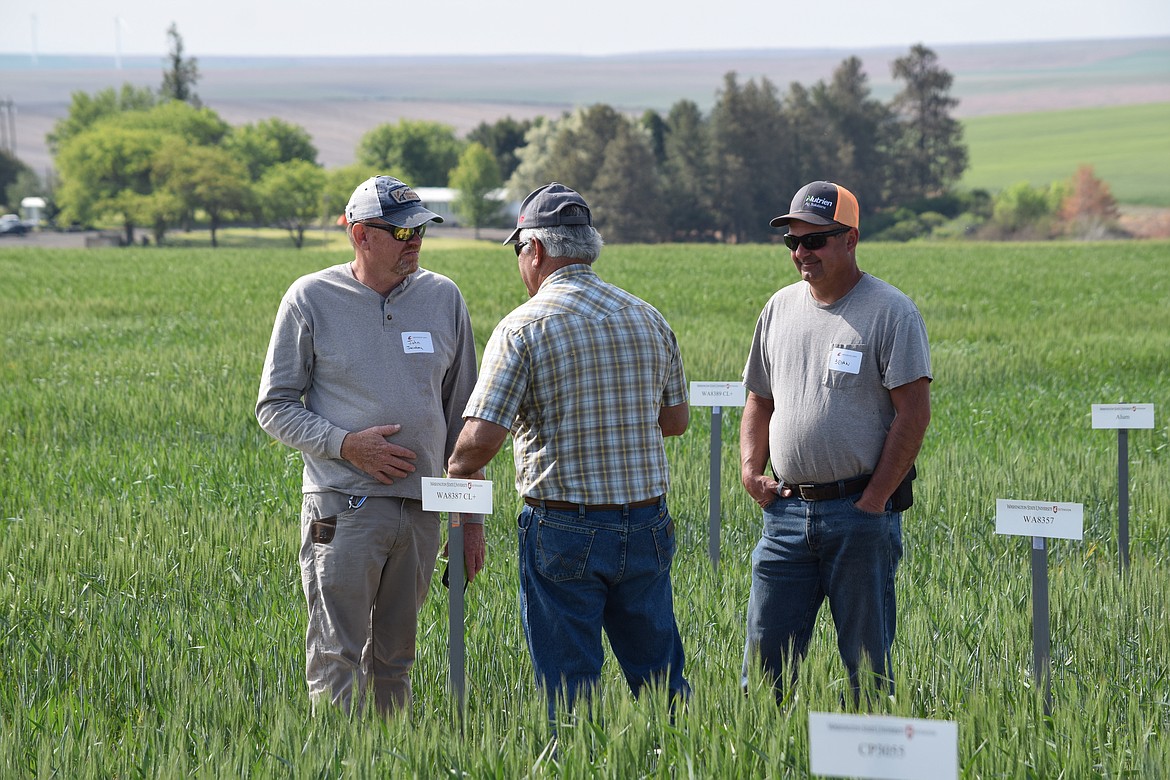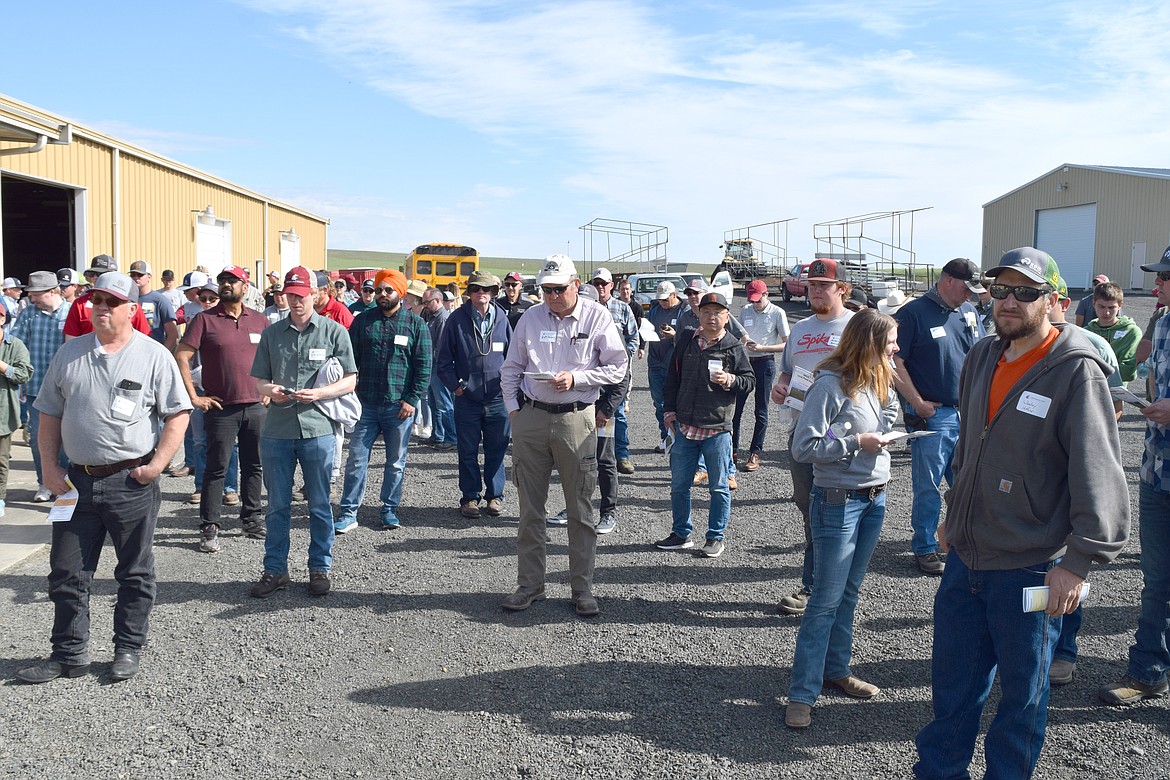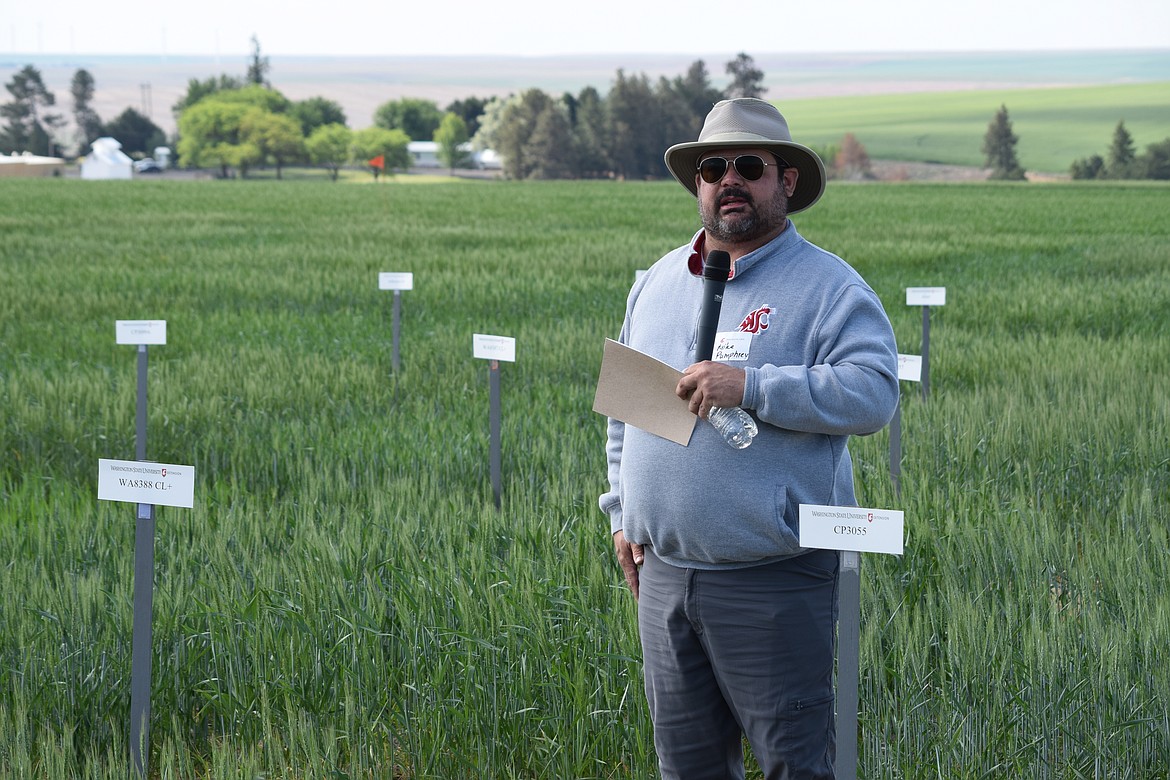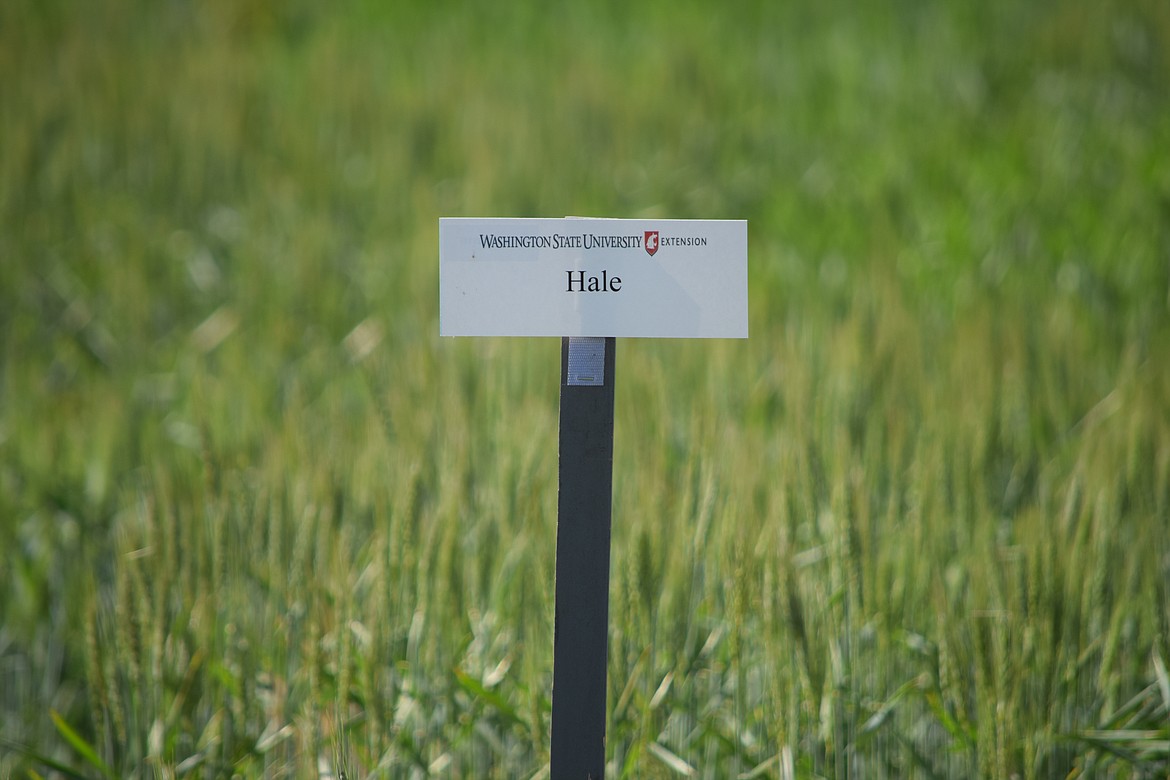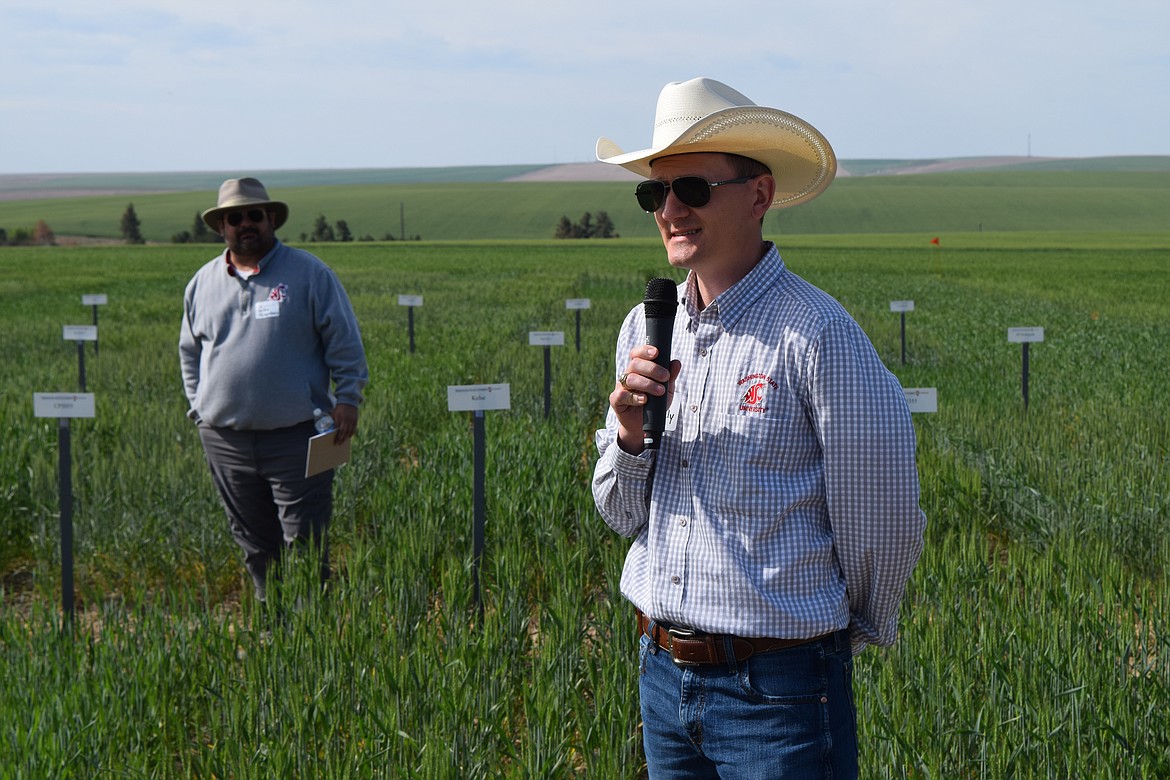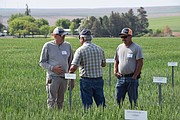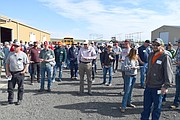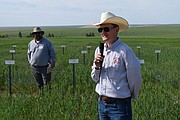'Wheat is king': Weather, disease, oil discussed at Dryland Institute field day
LIND — In 107 years, Washington State University’s Dryland Research Station in Lind has only had to cancel its field day three times.
Once in 1980, following the eruption of Mount St. Helens, and then in 2020 and 2021, because of the COVID-19 pandemic, according to Drew Lyon, interim chair of the Department of Crop and Sciences and a specialist in small grains research at Washington State University.
So it was a big deal when several hundred farmers and researchers from across Eastern Washington were able to gather on June 16 at the Dryland Research Station near Lind for the first time since 2019 to see what new varieties of winter and spring wheat were being evaluated, options for dryland oilseed crops in rotation, potential fungus problems this growing season and some of the latest in chemical application technology.
“I would say this is our premier field day at Washington State University. And not being able to do it for two years was really kind of a bummer. So it’s really nice to get back,” Lyon said.
WSU created the Dryland Research Station in 1915 to promote dryland farming on 320 acres donated to the university by Adams County, according to the station’s website. Research at the facility focuses primarily on wheat, though since 1928 the station has hosted test stands of drought-resistant trees and shrubs to test which would make better windbreaks, and a stand of nearly 100 drought-tolerant Austrian pine trees planted in 1976 from seeds acquired around the world burned down last summer following a wildfire.
Central Washington receives, on average, between 8-12 inches of precipitation in the form of both snow and rain in an average year, with the rain shadow falling darkest on the Columbia Basin and the area immediately east of the Cascades. Farther east, in the Palouse, precipitation can average as much as 20 inches per year.
Lyon said field day has managed to last more than a century because farmers in the region — and dryland wheat farming varies considerably from Douglas County south to Franklin County, east through Adams County and then all through the Palouse — are heavily invested in WSU and the research the university does to promote different varieties tailored to each region and help make farmers as successful as possible.
“It’s just a fun event,” he said. “It’s a beautiful day today, and the weather’s not always beautiful.”
Lyon said when he taught and did research in Nebraska, wheat was important, but it was secondary to corn and soybeans. In Eastern Washington, however, there really aren’t many good alternatives for dryland farming.
“Wheat is king. It’s the main focus of a lot of what we do. We do look at alternative crops because to grow good wheat you need some crops to rotate with it. There is some of that. But a lot of emphasis is on wheat,” he said.
Spring and winter variety trials
As Mike Pumphrey stood in the midst of five-foot by eight-foot test plots of different spring wheat varieties waving gently in the breeze, he apologized to the group of farmers gathered around him for not being properly prepared for this year’s spring wheat trials.
“How much rain did you guys know we were going to get from about the 10th of March until now?” he asked. “You planned on wind. Did anybody plan on a bunch of rain?”
Pumphrey asked because of last year’s drought and heat wave. Last summer, a little more than half-an-inch of rain was recorded falling on the Lind Dryland Research Station from March through the end of September, with high temperatures reaching 114 degrees Fahrenheit on June 29 and 30. In comparison, nearly an inch of rain fell in March 2022 alone, with another inch recorded in April and nearly an inch in May, according to station data.
WSU extension agronomist Clark Neely said the goal of the program is to test different wheat varieties specialized for each of Eastern Washington’s very different growing areas. Neely, who is based in Pullman, said the program tests wheat and barley everywhere small grains are grown in Washington — from northern Lincoln County south to Walla Walla and east to the Palouse, including two irrigated test plots in the Columbia Basin. Most of those locations are grower fields, Neely added, and not WSU land.
“In total, we do approximately 90 individual trials that we publish on our small grains website,” Neely said (smallgrains.wsu.edu). “The trials themselves are pretty considerable, especially the software trial, we have on average about 54 entries each year, usually a third, almost a half of those are experimental.”
Pumphrey, who moved his wheat trials to St. John this year because last year’s test wheat grew so poorly in Lind, said tests are designed to see which varieties of wheat perform best under local conditions.
“The justification for the past few years is heat and drought tolerance,” he said, noting that while this year has been much cooler and wetter than last, wheat breeders still need to deal with average climatic conditions. “Anytime you show up to a testing site … anytime you look at anybody’s data, you need to think about years, about broad adaptation and stability.”
“That’s really important for testing,” Pumphrey added.
Pumphrey pointed out a new variety, Hale, which he said has the highest average yield for all of Eastern Washington’s precipitation zones as well as strong resistance to wheat stripe rust
“I like Hale,” he said. “Dryland hard red spring wheat, seed dealers don’t want too many options. You need decent height and all that, but also good protein, broad adaptation, disease resistance, Hale’s pretty much got it all.”
Over in the winter wheat trials, Kim Garland-Campbell, a research geneticist with the U.S. Department of Agriculture’s Agricultural Research Service, said they planted the winter wheat test varieties later than normal, in early-October, because the lack of rain last year meant it was nearly impossible to find soil moisture even a foot down.
“I don’t think we’ve ever, that I know of, planted that late before,” she said.
Still, even with all the rain, the cooler than normal temperatures — it’s been about 10-12 degrees cooler than average across Eastern Washington — mean the wheat is about two weeks behind where it would normally be, Garland-Campbell added.
“It’s probably fully headed just last week. And as most of you know, our usual heading date here is the last week of May,” she said.
Gary Shelton, a WSU researcher who has helped develop several varieties of winter wheat, said late planting typically reduces yields by half and results in total wheat yields similar to spring wheat.
“When we plant late, if (normal yield is) 50 bushels, we’re at 25 late planted,” he said. “So, not great.”
Shelton highlighted a new variety currently awaiting release called WA8362, which he has shown a good ability to emerge well during the past six or so years of being grown in trials.
“It can come out from deep and fast,” he said, noting that in places like Adams County, wheat is often planted six or seven inches deep in order to tap latent soil moisture. “It’s close to some of the standard height reds that you guys plant out. So it gets tall, but it really emerges well.”
Boring is good
As a plant pathologist, WSU’s Tim Murray said he finds there’s nothing more interesting than a raging plant disease.
“It’s been a boring year,” he said of 2022. “ It’s been pretty quiet on the disease front.”
Murray said here have been some reports of stripe rust — a fungal infection that affects wheat leaves, disrupts photosynthesis and reduces yields — but since 2021 was so hot and dry, and stripe rust only infects wheat, there just isn’t all that much around. If you have stripe rust, however, Murray said it’s getting a little too late in the growing season to apply a fungicide, which needs to be applied before wheat flowers emerge.
Cassandra Bates, manager of WSU’s Plant Pest Diagnostic Clinic, agreed that it has been a boring year for plant pathologists, but added the cold and wet can cause their own problems for wheat, and are also conducive to the spread of soil-borne wheat mosaic virus, which infects winter wheat seeds as they sit in the soil waiting to germinate. Bates said the lab has found the virus in samples from Washington north of U.S. Highway 2 and then from the Idaho portion of the Palouse.
As they grow, wheat plants will recover from the virus, Bates said, but the infection will also permanently damage them as well. The only real solution is to grow resistant varieties, both Bates and Murray said.
“The good news is that we have resistance in a lot of the varieties that are adapted to the PNW,” Murray said. “We’ve known about this disease in the United States for over 100 years. Most of the Great Plains, the Midwest, and the east, have dealt with this disease for a long time. There’s a lot of efforts for breeding for resistance to this disease.”
Oilseed alternative
Finally, Wilson Craine, a seed breeder with Pure Line Seeds in Warden who also does research with WSU, showed off a test plot of camelina, an oilseed in the brassica family — the same family that includes, cabbage, kale, broccoli, mustard and canola — that he believes will make an effective rotation crop for wheat growers.
“This is part of what would be a three-year rotation instead of the traditional winter wheat-fallow rotation,” Craine said. “We planted this into fallow, the goal is to plant winter wheat right after it. And then that would be followed by another year of fallow.”
The test plot of camelina was planted side-by-side with a plot of pennycress, a type of mustard. However, Craine pointed to a sparse field covered mostly with weedy grass, noting the pennycress failed to emerge. The camelina survived the winter as seedlings, Craine said, and has grown pretty well since then, though the plant is not adapted to work with a broadleaf herbicide, and so weed control is going to be an issue.
Camelina also doesn’t do anything for the soil like a legume would, Craine said. The oil, however, which smells like fresh-mown grass and a very nutty, vegetable taste (it would mix well with garlic and dill in a salad dressing), can be used for both food and industrial uses, has a fatty acid profile similar to fish oils, and easily converts to kerosene-like biofuels such as diesel or jet fuel, Craine added.
Once the seeds are crushed for oil, Craine said the remaining seed meal is also a viable animal feed.
“So it’s a more sustainable alternative to fish oil and has a lot of the same health benefits associated with fish oil,” he said.
Craine said the biggest hurdle facing Washington farmers interested in camelina is the lack of local facilities. The oil samples he hands out were made by a grower who has his own small pressing facility, Craine said, adding that a lot of farmers in Montana are growing camelina, pressing it into oil, and then shipping it by train to California. It will simply take some time, and some interest, to develop the market infrastructure in the Pacific Northwest to process any camelina farmers decide to grow.
“So there is the potential for people who have interest to create a market. Especially where fuel prices are now, it could be a really economically attractive crop to grow,” he said.
Charles H. Featherstone can be reached at [email protected].



